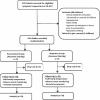Ibuprofen versus paracetamol for treating fever in preschool children in Nigeria: a randomized clinical trial of effectiveness and safety
- PMID: 33224416
- PMCID: PMC7664141
- DOI: 10.11604/pamj.2020.36.350.21393
Ibuprofen versus paracetamol for treating fever in preschool children in Nigeria: a randomized clinical trial of effectiveness and safety
Abstract
Introduction: fever is the primary symptom of most childhood illnesses and a cause of concern to their caregivers. The antipyretics commonly used to treat fever are ibuprofen and paracetamol. Most studies on the effectiveness of ibuprofen and paracetamol in treating fever in under-fives were conducted in Europe and North America with very few in African children. This study was aimed at assessing the effectiveness and safety of a single dose therapy of ibuprofen versus paracetamol for treating childhood fever in Nigeria.
Methods: a randomized, controlled clinical trial was conducted in the University of Calabar Teaching Hospital, in Nigeria. A total of 140 eligible children aged 6-59 months with tympanic temperature of 38°C-40°C were enrolled, and 70 of them were assigned to one arm that received a single dose of ibuprofen (10mg/kg) and 70 had paracetamol (15mg/kg). After drug administration, the children were admitted and observed in the hospital for six hours during which period a half-hourly temperature measurement and monitoring for adverse events were done.
Results: the overall result showed that ibuprofen had a better fever reducing effect compared to paracetamol. The proportion of afebrile children in the ibuprofen versus paracetamol group at 1.5-2.5 hours of administration of the drugs was statistically significant (p = 0.04). The adverse events of both drugs were mild and quite comparable with vomiting being the commonest.
Conclusion: ibuprofen is more effective in the treating fever in under-fives compared to paracetamol. The adverse events of both drugs were mild and comparable.
Keywords: Ibuprofen; effectiveness; fever; paracetamol; safety; trial; underfives.
Copyright: Ekaete Olajide Alaje et al.
Conflict of interest statement
The authors declare no competing interests.
Figures
References
-
- National Population Commission (NPC) [Nigeria] Abuja, Nigeria: NPC, NMCP, and ICF International. 2012. National Malaria Control Programme (NMCP) [Nigeria], and ICF International, Nigeria Malaria Indicator Survey 2010.
-
- Hay AD, Heron J, Ness A, the ALSPAC study team. The prevalence of symptoms and consultations in preschool children in the Avon Longitudinal Study of Parents and Children (ALSPAC): a prospective cohort study. Fam Pract. 2005;22:367–74. - PubMed
-
- WHO. World Health Organization, City. 2005. Handbook: Integrated Management of Childhood Illness, In Book Handbook, Integrated Management of Childhood Illness.
-
- Black RE, Cousens S, Johnson HL, Lawn JE, Rudan I, Bassani DG, et al. Global, regional, and national causes of child mortality in 2008: a systematic analysis. Lancet. 2010;375:1969–87. - PubMed
Publication types
MeSH terms
Substances
LinkOut - more resources
Full Text Sources
Medical


